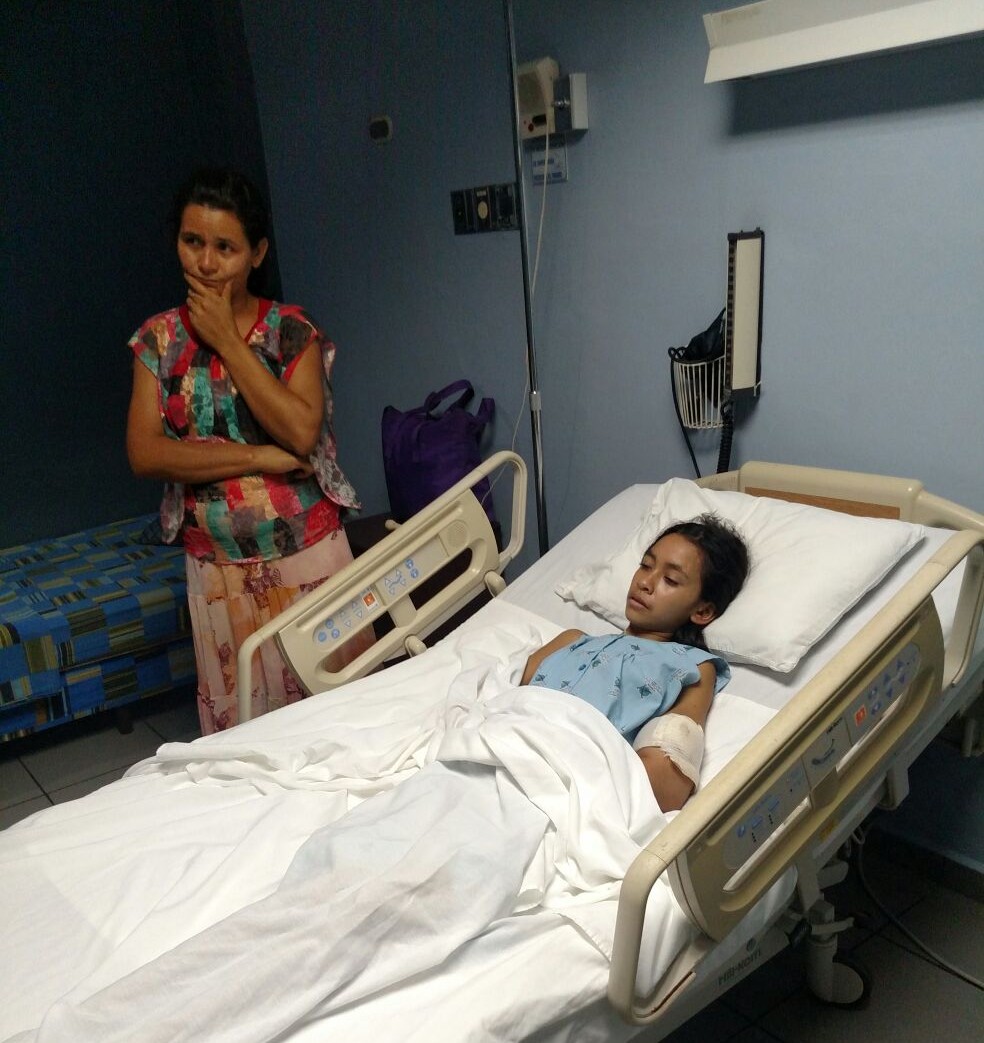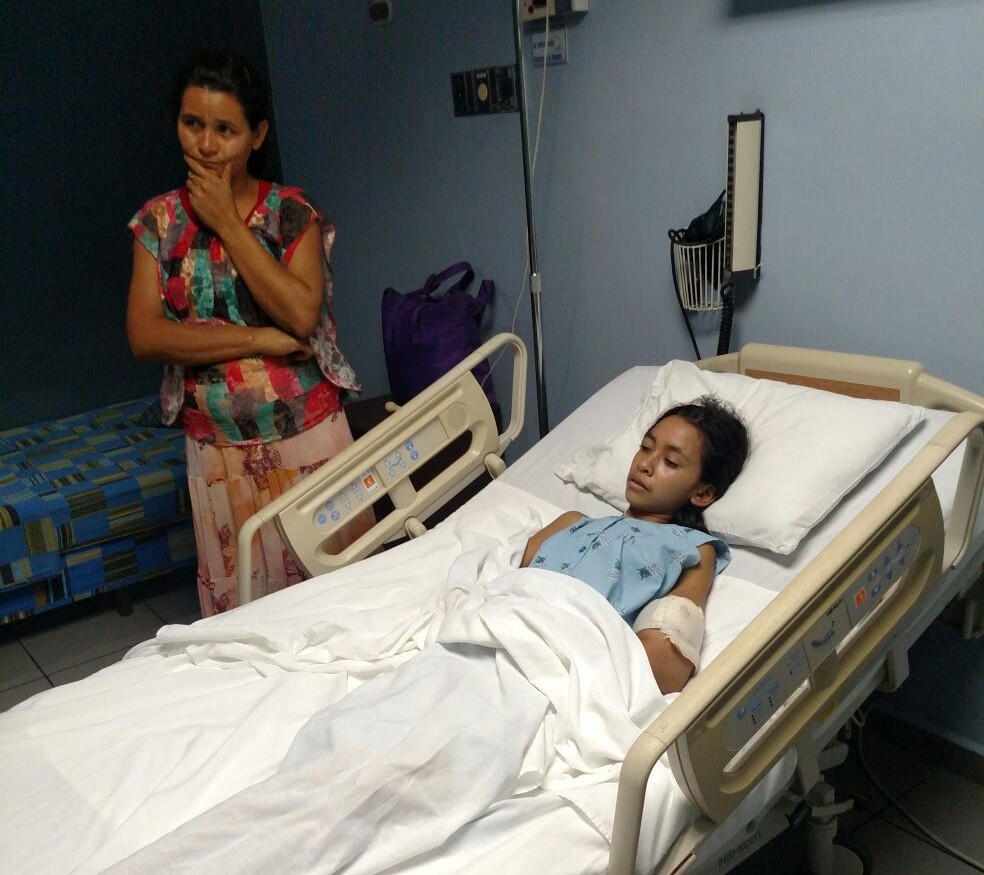“There is a saying in El Salvador: The wealthy have the freedom to live, and the poor have the freedom to die.”
What are your feet or legs worth?
How about your back?
What is the ability to be able to sit up worth?
Your arms – what value do you give one of them?
What about your life?
We went to visit Mr. Maravilla this week, after he had been admitted to a government hospital. The local police helped transport him there while Andrés worked on a game plan to find a solution for him to get “real help.” Let me explain why I say “real help.”
When someone visits a government hospital in El Salvador, he is only allowed to visit for 1 hour and only from 12:00 – 1:00 PM. It doesn’t matter if it is your wife, mother, husband, or grandparent; these are the strict rules. After we were allowed in, we found Maravilla in a 20 x 25 foot room with ten patients positioned around the ward. There were twenty other people visiting their family member or friend, all crowding into the same room. We sat down next to Maravilla on an empty cot across from him. I thought it was odd that he was wearing the same soiled clothing that he had on days before entering the hospital, and he had not been cleaned up. His skin was still covered with dirt and grime from living on the streets.
There was every kind of patient crammed into this one room. Lying about four feet from where I was sitting was a gentleman with his head toward me. He looked to be in very bad condition. Family members were gathered around him and touching him with their hands. It wasn’t until the priest came in that I realized that this man had died that hour amongst all the commotion in the room. It became apparent to me that this is the way it is at the public hospitals in El Salvador; you share your grief with total strangers as you watch your loved one die.
We listened to Maravilla retell his story and left when our hour was up. There were 10-12 cots scattered along the hallway filled with patients in need of help. They had the look of “did somebody forget about me” on their faces. When we got outside, I wondered where Andrés was going; I thought we would proceed to where we had parked. Instead, he headed towards a little building with an open front. Through the opening, he gave orders to the lady attendant. She quickly returned with a bag filled with some items, and we paid for them. Inside the bag was a roll of toilet paper, a bar of soap, and a gallon jug of water. We delivered our gift bag to the grateful man, Mr. Maravilla. Andrés could see the bewilderment on my face. He explained in a ‘why would you not know this’ tone that a patient has to provide his own water to drink, soap to clean up with, and his own toilet paper. In silence, I thought that was unbelievable, and it no wonder he looked the way he did. The only treatment he will receive before being released from the hospital is a prescription for a certain type of bandage. He was prescribed no antibiotics, and no one deep cleaned his wounds. He was only given a little something to help kill the pain.
The disparities between the public and private health care in El Salvador is a sin that is hard to accept. Those that have resources do not notice, and the poor just accept it as the way it is. Most give up and many times do not attempt to find help at the public clinics because they know it is just an effort in futility. I am certain you will hear the rest of Mr. Maravilla’s story in the coming weeks.
Yesterday, as we facilitated a project for another entity, we ran into a young thirteen year old girl named Reina. We have known her family for the past eight years. I could tell she was in great pain by the look on her face and the way she held her arm and protected it. Reina’s aunt told us how the family members take turns staying up with her at night because the pain is so significant. She is not able to stay asleep until she is completely exhausted. The problem with her left arm started just four months ago as a small bump the size of a pea. Since this lump appeared, we have occasionally inquired about her progress, taking for granted that she was being taken care of. The lump is now the size of a football encircling her arm just above the elbow. It dwarfs her skinny arm as she now weighs only 67 pounds.
Reina and her mother, Maria, have spent six weeks in three different public hospitals. One week in a smaller hospital, another week in a large regional hospital, and a month in the largest national hospital. Reina has undergone many tests that she had to go elsewhere to get and pay for and bring back for the hospital to have, yet has never received the results from them. The most recent test was a biopsy taken weeks ago, and she still has not heard an outcome. When Reina was in the public hospitals, she had a bed in a ward (room) with up to twenty patients and hardly enough room for the nurse to maneuver. Since she is a child, her mother was allowed to stay with her. Maria was given a straight back wooden chair to sit and sleep on by her daughter, if sleep could even be possible.
Reina was always sent home from the public hospitals before getting any answers or any type of treatment. The only conversation that was had with the doctors was that the lump is probably a tumor, and her arm may need to be removed. Her arm has now swelled to triple in size in the four valuable weeks she has waited for test and biopsy reports that will probably never be processed.
After seeing Reina at her home that day, I could tell that time was of the essence if there was going to be an opportunity to help her. After consulting with her and her mother and father, they agreed to let us take her to Our Lady Of Peace Hospital. It is a private medical center that we have received great medical care from on other cases. It is located in San Miguel, an hour drive from Berlin.
Within 45 minutes of arriving at the ER, Reina was admitted, taken to an examination room, had been seen by two doctors, had an iv port installed, a consult with her and her mother, and a battery of tests ordered and started. Her private hospital room at Our Lady Of Peace Hospital consisted of her hospital bed, a single sized bed for her mother, a bathroom and shower, climate controlled, large screen TV, and two evening meals for both of them, after the tests for that late afternoon had been completed.
I could tell by the conversation and solemnity of the doctors and support staff that they knew they were dealing with a serious and life threatening situation. We were informed that a team of specialists would consult and the results of her tests and biopsy would be known in 3-4 days. They would then decide and proceed on a course of treatment. The distraught look on Maria’s face was still there as she looked at and hovered over her daughter as she lay in the hospital bed. One would hope for her some semblance of hope.
As we were leaving Reina’s room, I looked at her. It was hard not to think that could be one of my granddaughters lying there.
WHAT IS THE VALUE OF REINA’S ARM? WHAT IS THE WORTH WE GIVE HER LIFE?
Jerry
















